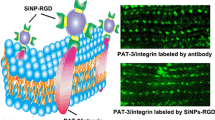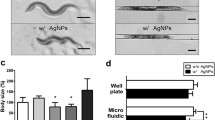Abstract
Here we have demonstrated a novel single step technique of synthesis of highly fluorescent carbon nanoparticles (CNPs) from broth constituent and in vivo bioimaging of Caenorhabditis elegans (C. elegans) with the synthesized CNPs has been presented. The synthesized CNPs has been characterized by the UV-visible (UV-Vis) absorption spectroscopy, transmission electron microscopy (TEM) and Raman studies. The sp 2 cluster size of the synthesized samples has been determined from the measured Raman spectra by fitting it with the theoretical skew Lorentzian (Breit-Wigner- Fano (BWF)) line shape. The synthesised materials are showing excitation wavelength dependent tunable photoluminescence (PL) emission characteristics with a high quantum yield (QY) of 3 % at a very low concentration of CNPs. A remarkable increase in the intensity of PL emission from 16 % to 39 % in C. elegans has also been observed when the feeding concentration of CNPs to C. elegans is increased from 0.025 % to 0.1 % (w/v). The non-toxicity and water solubility of the synthesized material makes it ideal candidate for bioimaging.




Similar content being viewed by others
References
Iijima S, Ajayan PM, Ichihashi T (1992) Growth model for carbon nanotubes. Phys Rev Lett 69:3100–3103
Sun YP, Zhou B, Lin Y, Wang W, Fernando KAS, Pathak P, Megiani MJ, Harruff BA, Wang X, Wang HF, Luo PG, Kose ME, Chen B, Veca LM, Xie XY (2006) Quantum sized carbon dot for bright and colourful photoluminescence. J Am Chem Soc 128:7756–7757
Xu X, Ray R, Gu Y, Polehn HJ, Gearheart L, Raker K, Scrivens WA (2004) Electrophoresis analysis and purification of fluorescent single-walled carbon nano tube fragments. J Am Chem Soc 128:12736–12737
Gokus T, Nair RR, Bonetti A, Bohmler M, Lombardo A, Novoselov KS, Geim AK, Ferrari AC, Hartchuh A (2009) Making graphene luminescent by oxygen plasma treatment. ACS Nano 3:3963–3968
Rahy A, Zhou C, Zheng J, Park SY, Kim MJ, Jang I, Cho SJ, Yang DJ (2012) Photoluminescent carbon nanoparticles produced by confined combustion of aromatic compound. Carbon 50:1298–1308
Sadhanla HK, Nanda KK (2016) Boron-doped carbon nanoparticles: size independent color tenability from red to blue and bioimaging application. Carbon 96:166–173
Tong G, Wang J, Wang R, Guo X, He L, Qiu F, Wang G, Zhu B, Zhu X, Liu T (2015) Amorphous carbon dots with high two-photon fluorescent for cellular imaging passivated by hyperbranched poly (amino amine). J Mater Chem B 3:700–706
Yang Y, Cui J, Zheng M, Hu C, Xiao Y, Wang Q, Liu Y (2012) One-step synthesis of amino-functionalized fluorescent carbon nanoparticles by hydrothermal carbonization of chitosan. Chem Commun 48:380–382
Ray SC, Saha A, Jana NR, Sarkar R (2009) Fluorescent carbon nanoparticles: synthesis, characterization, and bioimaging application. J Phys Chem C 133:18546–18551
Sahu S, Behera B, Maity TK, Mohapatra S (2012) Simple one-step synthesis of highly luminescent carbon dots from orange juice: application as excellent bio-imaging agents. Chem Commun 48:8835–8837
Kasibabu BSB, D’souza SL, Jha S, Kailas SK (2015) Imaging of bacterial and fungal cells using fluorescent carbon dots prepared from papaya juice. J Flouresc 25:803–810
Chandra S, Das P, Bag S, Laha D, Pramanik P (2011) Synthesis, functionalization and bioimaging applications of highly fluorescent carbon nanoparticles. Nanoscale 3:1533–1540
Zheng Y, Yang D, Wu X, Yan H, Zhao Y, Feng B, Duan K, Weng J, Wang J (2015) A facile approach for synthesis of highly luminescent carbon dots using vitamin-based small organic molecules with benzene ring structure as precursors. RSC Adv 5:90245–90254
Wang J, Ng YH, Lim YF, Ho GW (2014) Vegetable extracted carbon dots and their nano composites for enhanced photo-catalytic H2 production. RSC Adv 4:44117–44123
Zhu S, Song Y, Zhao X, Shao J, Zhang J, Yang B (2014) The photoluminescence mechanism in carbon dots (graphene quantum dots, carbon nano dots and polymer dots): current state and future perspective Nano Res 8: 355–381
Li L, Wu G, Yang G, Peng J, Zhao J, Zhu JJ (2013) Focusing on luminescent graphene quantum dots: current status and future perspectives. Nanoscale 3:4015–4039
Riggs JE, Guo Z, Caroll DL, Sun YP (2000) Strong luminescence of solubilized carbon nanotubes. J Am Chem Soc 122:5879–5880
Mochalin VN, Gogotsi Y (2009) Wet chemistry route hydrophobic blue fluorescent nanodiamonds. 131:4594–4595
Yang ZC, Li X, Wang J (2011) Wang (2011) intrinsically fluorescent nitrogen containing carbon nano particles synthesized by a hydrothermal process. Carbon 49:5207–5212
Peng J, Gao W, Gupta BK, Liu Z, Romero-Aburto R, Ge L, Song L, Alemany LB, Zhan X, Gao G, Vithayathil SA, Kaipparettu BA, Marti AA, Hayashi T, Zhu JJ, Ajayan PM (2012) Graphene quantum dots derived from carbon fibers. Nano Lett 12:844–849
Holfmann R (1968) Organic and biological chemistry. J Am Chem Soc 90:1475–1485
Liu F, Jang MH, Ha HD, Kim JH, Cho YH, Seo TS (2013) Facile synthesis method for pristine graphene quantum dots and graphene oxide quantum dots: origin of blue and green luminescence. Adv Mater 25:3657–3662
Saxena M, Sonkar SK, Sarkar S (2013) Water soluble nano carbons arrest the growth of mosquitos. RSC Adv 3:22504–22508
Ferrari AC, Robertson J (2000) Interpretation of Raman spectra of disordered and amorphous carbon. Phys Rev B 6:14095–14104
Chen B, Kadowaki Y, Inoue S, Ohkohchi M, Zhao X, Ando Y (2010) New Raman-peak at 1850 cm−1 observed in multiwalled carbon nanotubes produced by hydrogen arc discharge. J Nanosci Nanotechnol 10:4038–4042
Tuinstra F, Koenig JL (1970) Raman spectrum of graphite. J Chem Phys 53:1126–1130
Ferrari AC, Robertson J (2004) Raman spectroscopy of amorphous nanostructured diamond-like carbon and nano diamond. Phil Trans R Soc Lond A 362:2477–2512
Wang L, Wang Y, Hu T, Liu H, Yao C, Liu Y (2014) Gram scale synthesis of single crystalline graphene quantum dots with superior optical properties. Nat Commun 5:5357–5366
Li H, He X, Kang Z, Huang H, Liu Y, Liu J, Lian S, Tsang CH, Yang X, Lee ST (2010) Water soluble fluorescent carbon quantum dots and photo catalytic design. Angew Chem Int Ed 49:4430–4434
Rusli RJ, Amaratunga GAJ (1996) Photoluminescence behaviour of hydrogenated amorphous carbon. J Appl Phys 80:2998–3003
Li H, Kang Z, Liu Y, Lee ST (2012) Carbon nano dot: synthesis properties and applications. J Mater Chem 22:24230–24253
Gue X, Wang CF, Yu ZY, Chen L, Chen S (2012) Facile access to versatile fluorescent carbon dots toward light-emitting diodes. Chem Commun 48:2692–2694
Qu Y, Li W, Zhou Y, Liu X, Zhang L, Wang L, Li YF, Lida A, Tang Z, Zhao Y, Chai Z, Chen C (2011) Full assessment of fate and physiological behaviour of quantum dots utilizing Caenorhabditis elegans as model organism. Nano Lett 11:3174–32183
Ewbank JJ, Zugatsi O (2011) C. elegans: model host and tool for antimicrobial drug discovery. Dis Model Mech 4:300–304
Sonkar SK, Ghosh M, Roy M, Begum A, Sarkar S (2012) Carbon nano-onions as nontoxic and high-fluorescence bioimaging agent in food chain – an in-vivo study from unicellular E. coli to multicellular C. elegans. Mater Express 2:105–113
Gerstbrein B, Stamatas G, Kollias N, Driscoll M (2005) In-vivo spectrofluorimetry reveals endogenous biomarkers that report health span and dietary restriction in Caenorhabditis elegans. Aging Cell 4:127–137
Acknowledgments
The authors are thankful to CSIR for the partial financial support with grant No. 03(1328)/14/EMR-II, dt. 03.11.2014. Authors are also grateful to Ms. Ranjana Singh, and Prof. Ranjan Singh, Dept. of Physics, Institute of Science, BHU, Varanasi, India for their help in taking the Raman spectra.
Author information
Authors and Affiliations
Corresponding author
Rights and permissions
About this article
Cite this article
Pramanik, A., Kole, A.K., Krishnaraj, R.N. et al. A Novel Technique of Synthesis of Highly Fluorescent Carbon Nanoparticles from Broth Constituent and In-vivo Bioimaging of C. elegans . J Fluoresc 26, 1541–1548 (2016). https://doi.org/10.1007/s10895-016-1854-8
Received:
Accepted:
Published:
Issue Date:
DOI: https://doi.org/10.1007/s10895-016-1854-8




